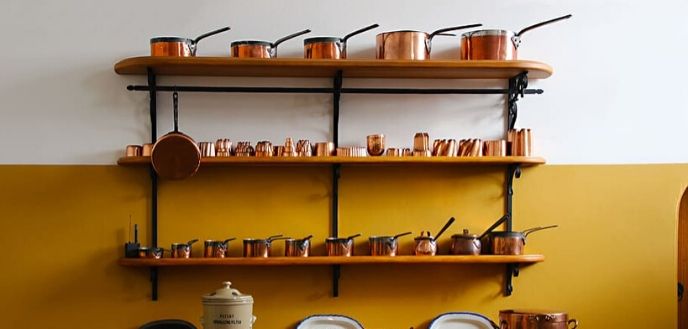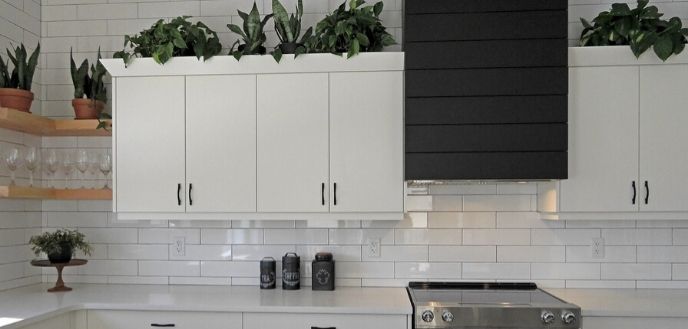If you’re an avid cooking enthusiast, there’s nothing worse than a tiny kitchen cramping your style. But even if a major remodel isn’t in your budget, there are plenty of ways to optimize the space you have and make your small kitchen work for you. Check out these small kitchen decorating, storage and mini-remodeling ideas to expand your cooking space in a big way.
15 Ways to Make a Small Kitchen Look Bigger
1. Stick to white or light colors
Dark colors in small spaces tend to crowd the eye and make a room feel claustrophobic. Use white or light colors on both your walls and cabinets to reflect light around your kitchen and make it feel bigger.
2. Accent with bright pops of color
If you hate the idea of a stark white cooking space, fear not – strategically accenting with bright pops of color can draw a person’s eye around your kitchen, making it look and feel bigger.
3. Use open shelving

Cabinets are great, but to make a small kitchen look bigger and give the space a little more depth, opt for doorless, open shelving to store plates, bowls and other cooking supplies.
Budget option: Not ready to shell out for new cabinets? Taking the doors off and putting matching trim over the edges is an easy way to convert your old ones into new open shelving.
4. Opt for a mirrored backsplash
In small spaces, the name of the game is reflect, reflect, reflect. A mirrored backsplash is a great way to expand the feel of your small kitchen, as it spreads light around the room, keeping it bright and well-lit.
Pro-Tip: If mirrored glass tiles aren’t in the budget, there are plenty of reflective peel-and-stick backsplashes that can accomplish the same feel without the hefty price tag.
5. Use high-gloss paint
Glossy paint will help to bounce light around your small kitchen and keep it feeling well-lit, open and spacious.
6. Avoid sharp contrasts between walls and cabinets

Your walls and cabinets don’t have to be the same shade, but avoid stark color contrasts between the two. Having a large block of dark cabinets against a light wall or vice-versa can draw attention to the scarcity of space in your kitchen, making it look and feel even smaller.
7. Leave your ceiling white
A smooth white ceiling will keep your kitchen from feeling boxed in, so if your ceiling is white, leave it be. If it’s not, paint it white and if you have popcorn ceilings, have it scraped off to remove the harsh shadows and contrasts they cast, which can also make a kitchen feel smaller.
Pro-Tip: While many projects on this list are DIY-worthy, painting ceilings and removing popcorn texture from a ceiling are projects best left to the pros. Get in touch with a painting professional or a home maintenance professional to help tackle these and make your kitchen feel bigger.
8. Paint your trim the same color as your walls
Trim that contrasts with your wall color can make a room feel short and cut off at the top. By painting your trim the same color as your walls, you’ll extend the plane, making your kitchen feel taller and unconfined.
9. Install soft under-cabinet lighting

Using soft, diffused under-cupboard lighting is an easy way to bring out the depth in a small kitchen space. Use linear lights underneath cabinets for shadow-free task lighting and to help make your kitchen look a little less cramped.
10. Add a skylight
If you can swing it, installing a fixed skylight is an awesome way to add natural light without taking out valuable wall or cabinet space.
Pro-Tip: Fixed skylights can be expensive, but tubular skylights are a budget-friendly option that are especially great for small kitchens and other spaces, as they are more compact and easier to install.
11. Soften up your window treatments
Play up the natural light you have by choosing the right window treatments. Cordless blinds with clean, sharp lines can cut down on visual clutter and give your kitchen a bigger feel. If blinds aren’t your thing, use sheer, light curtains to diffuse light and give the room a softbox effect.
12. Pick the right size kitchen island light

If you have a permanent kitchen island, choosing the right size overhead lighting for it can make a big difference. To open up the space, use clear, shadeless fixtures so the light will spread throughout the room, instead of focusing hard light on the counter alone.
Also, choosing the right size kitchen island light can make a big difference. Instead of opting for one large light, consider using several smaller bulb pendant lights for more illumination. Make sure to hang them so that they do not obstruct the view of the tallest person to use the island while they are standing – this extra height will make your kitchen appear bigger and less crowded.
13. Choose shiny flooring materials
Glossy, light subway tiles are a great choice for smaller kitchens, as they tend to bounce light around the space and provide slender, clean lines throughout.
Pro-Tip: Stick to clean lines for decor and fixtures to eliminate visual noise in your kitchen. This will make it appear less cluttered and more spacious.
14. Store seasonal or larger appliances in another room
Clutter can make any room feel smaller, especially the kitchen. If you only break out the deep fryer once a year for Thanksgiving, don’t let it take up valuable pantry space; box it up and store it in the basement or a hall closet until you need it.
15. Free up space by hanging up smaller items

If you’re looking for more ways to eliminate clutter and open up your kitchen, here are a few small kitchen storage ideas to make the most of your space:
- Pot rack hooks: Hang up pots and pans to free up cabinet space.
- Magazine racks: Attach these to the inside of cabinets or on pantry walls to store cling wrap, aluminum foil and other supplies.
- Over-the-door shoe organizer: Can be used to store spices, condiment packets, cleaning supplies, individual snack packets, and so much more.
Want a bigger kitchen? Call Handyman Connection today
Whether you need help installing any of these small-kitchen hacks or want to tackle a full-scale kitchen remodel, Handyman Connection can help. With locations throughout the United States and Canada, we’re your local connection to the top craftsmen in your area, providing a wide variety of expert handyman services including electrical, carpentry, flooring, plumbing and more. Call 1-800-88-HANDY to connect today, or find a location near you.
The post How to Make a Small Kitchen Look Bigger appeared first on Handyman Connection.